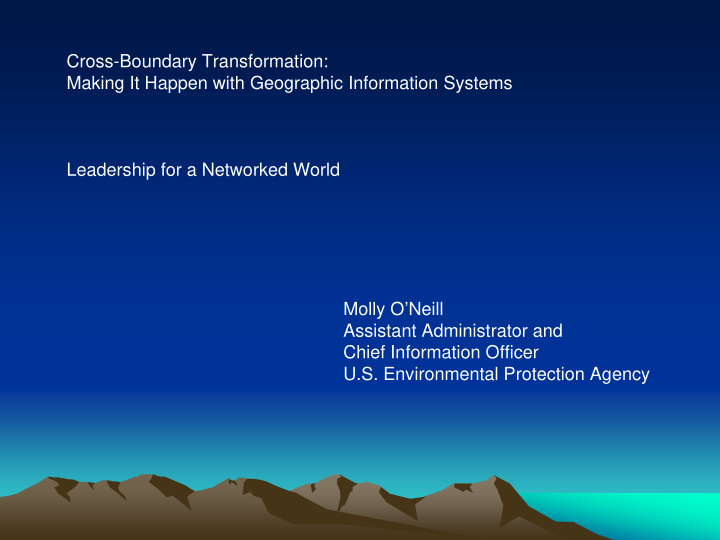



Cross-Boundary Transformation: Making It Happen with Geographic Information Systems Leadership for a Networked World Molly O’Neill Assistant Administrator and Chief Information Officer U.S. Environmental Protection Agency
GIS as an Enabler for Transformation GIS as an Enabler for Transformation • GIS has become a mainstream, core enabling technology in the IT enterprise • EPA and other organizations are at various stages in the identification of business processes that can benefit from spatial intelligence • EPA is a place-based organization – multiple requirements for deep integration of geospatial data and analytics • GIS tools and services are transforming cross jurisdictional and sector boundaries in many ways at EPA: – Empowerment of stakeholders to carry out their own spatial visualization of key data (mashups) – Standardization of data capture, management and presentation across geographically distributed programs – Location is a critical element that enables the merging of multi-media data stovepipes into common picture (Air, Water, Land, etc.)
The Importance of Standards The Importance of Standards • Open standards are critical to success within the EPA geospatial program and among EPA and our partners – Open Geospatial Consortium standards have come a very long way in a short time and are rapidly being adopted and supported in government • Data collection, storage and distribution standards – Ensuring that data received from our partners is ready for integration with new and existing data warehouses / marts and ready for exploitation with geospatial tools (e.g., GML / GEORSS adoption by Exchange Network partners) – Federated data and services architectures require common standards
Future (Near Term) Focus Future (Near Term) Focus • Geospatial application interface development becoming less of a focus – ESRI ArcGIS Explorer, Google Earth, MS Virtual Earth, etc. are now in wide use • Geospatial visualization reaching (has reached?) critical mass on the internet – now mainstream • Little need to spend development time on base map and associated cartography – can spend effort on presentation of Agency data – Focus changing to making data services available in consistent, discoverable manner – Interfaces and tools developed to provide access to geospatial analytical capacity
EPA GIS Yesterday / Today / Tomorrow EPA GIS Yesterday / Today / Tomorrow • Yesterday – Successful branding of multiple EnviroMapper applications http://www.epa.gov/enviro/html/em/ • Today – Migration to geospatial web services • http://geodata.epa.gov – Continued expansion of EnviroMapper suite of applications with view towards updating with commercial data services and toolkits (ESRI ArcWeb / Microsoft Virtual Earth / Google Maps) • Tomorrow – More geospatial data and application services – Geospatial Mashups – Let the community determine how to visualize and present EPA data • http://niceguy.wustl.edu/DataFedGoogle • http://www.terraims.com/webservices/superfund.php • http://www.wikimapia.org
Transformation…..is here Transformation…..is here • Drivers – Technology is ready – Public Demand – Communities, including partners are willing – At EPA, environmental data is becoming a commodity… • Land revitalization locations for developers and real estate agents • Beach quality/closure for hotel industries
Transformation….. Transformation….. • Is Government ready to work with collaborative tools? – Enviro-Wiki-Mapia for public to locate new releases to environment? • Partners vs. Public • Is Government ready to expose data to serve up to networked world?
Recommend
More recommend